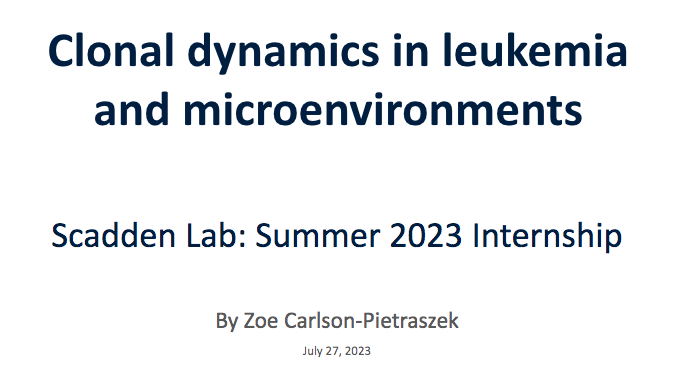
Clonal dynamics in leukemia and microenvironments
Author:
Zoe Carlson-Pietraszek ’25Co-Authors:
Faculty Mentor(s):
Thomas SpitzerFunding Source:
Spitzer Undergraduate Medically-Related Summer InternshipAbstract
This summer I had the opportunity to work in Dr. David Scadden’s lab in the Department
of Stem Cell and Regenerative Biology at Massachusetts General Hospital. I joined post-doctoral fellow, Trine Kristiansen, and lab tech, Samuel Keyes, on their ongoing research project studying how clonal changes in the stroma influence the leukemic cell, and differential sensitivities to
treatment from specific leukemic clones. We are specifically studying Acute Myeloid Leukemia
(AML), as it kills over 50% of the almost 18,000 adults in the U.S. diagnosed each year (Aitbekov, et al. Asian Pac J Cancer Prev, 2022). In practice, we use two methods of barcoding cells to obtain clonal information from both the stroma and leukemia: the CARLIN-Cas9 model and lentiviral integration. Both systems require a barcode library to obtain single cell resolution, and are designed to track single clones. The CARLIN model was developed by Dr. Fernando Camargo’s lab as a mouse line capable of in-vivo generation of transcribed barcodes in response to doxycycline induction. We use the CARLIN mouse model to obtain information about the
genetic diversity of the stroma. Unlike hematopoietic stem cells, stromal cells cannot be transplanted. Use of the CARLIN model allows us to barcode stromal cells without transplantation or irradiation, which might otherwise cause architectural changes in the stroma. In the CARLIN system, there are 10 guide RNAs and 10 target sites on the DNA which are always expressed. In order for the DNA to be cut to create a unique barcode, the protein Cas9 must be activated. We use an inducible system by controlling when Cas9 is activated in the
mouse by introducing doxycycline in their water or by injection. The guide RNAs bind to the Cas9 and guide it to the DNA target sites, where the Cas9 makes random cuts to produce a unique barcode per each cell. This barcode is then read out through sequencing, allowing us to identify and categorize clones. In the second barcoding system, we introduce barcodes into cells via lentiviral integration. This method allows us to control the number of barcodes made, because the diversity is determined by the random base pairs and lengths. This method involves
transplantation, but we use it for leukemia because radiation will not structurally affect it. Radiation can be used to eliminate HSCs within the marrow in preparation for transplantation. Lentiviral transduction is performed on HSCs cultured in vitro (in PVA media), which are then transplanted into the irradiated mice. The hematopoietic system is therefore replaced with barcoded cells. The barcodes are read out by sequencing before and after treatment and leukemia are introduced into the leukemia and stroma, respectively. These barcode readouts determine if certain clones are more resistant to leukemia treatment. If resistant clones are identified, treatments can be modified to target these specific clones so that relapse in AML patients is less likely.
I conducted my own in vitro experiment testing the three most common AML drugs in
clinical settings, Venetoclax, Azacitidne, and Cytarabine, on our EAS12 leukemia cell line. The
drugs were only introduced to the cells for 24 hours, because we wanted to observe the
immediate response without the possibility of resistant clones persevering throughout 24 hours of
exposure to treatment. Venetoclax takes longer to kill leukemic cells, so this experiment could be
done with a longer drug exposure time next.
From the data that I was able to obtain this summer, I was able to conclude that the AML
treatments are successful in killing the leukemic cells, the combination of Venetoclax (300 nM)
and Azacitine (3 uM) was the most successful treatment in three groups of different cell
numbers, and we had successful barcoding of our EAS12 cells that were injected into our mice
on July 14.